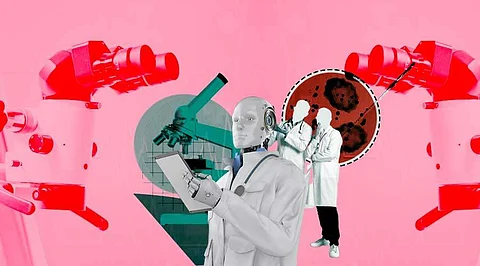

Medical robots are transforming healthcare, offering precision, automation, and innovation. From the da Vinci Surgical System's precise surgeries to the PARO Therapeutic Robot providing emotional support, these medical robots in healthcare makes revolutionary Impact.
Medical robots are transforming healthcare, revolutionizing patient care, and surgical procedures. These robotic systems, equipped with advanced technology and artificial intelligence, play a pivotal role in improving precision, efficiency, and patient outcomes. From the da Vinci Surgical System's intricate surgeries to the PARO Therapeutic Robot providing emotional support, these robots cater to diverse healthcare needs. The medical robots exemplify the fusion of technology and medicine, offering a brighter, more promising future for healthcare industry by enhancing diagnostics, treatments, and patient experiences. Let's delve into the top 5 medical robots in healthcare making impact:
The da Vinci Surgical System is a cutting-edge robotic platform designed to enhance surgical procedures. Developed by Intuitive Surgical, this system allows surgeons to perform minimally invasive surgeries with precision and control. It consists of robotic arms equipped with surgical instruments and a high-definition 3D camera.
Surgeons operate the da Vinci system from a console, translating their hand movements into precise robotic actions. This technology enables smaller incisions, reduced blood loss, and faster recovery times for patients. The da Vinci robot has been utilized in various surgeries, including prostatectomies, gynecological procedures, and cardiac surgery.
The Xenex Germ-Zapping Robot is an innovative device designed to combat hospital-acquired infections by effectively destroying harmful pathogens and reducing the risk of cross-contamination. This robot employs a technology called pulsed xenon ultraviolet (UV) light to disinfect hospital rooms and other healthcare environments.
The process begins when the Xenex robot is wheeled into a room that needs disinfection. The robot's UV-C light emits powerful bursts of high-intensity UV light, which penetrate the cell walls of bacteria, viruses, and spores, damaging their DNA and rendering them unable to reproduce or cause infection. This thorough disinfection method kills a wide range of pathogens, including superbugs like MRSA and C. difficile, within minutes.
Healthcare facilities around the world have adopted the Xenex Germ-Zapping Robot as an integral part of their infection control protocols. This technology not only enhances patient safety but also contributes to significant cost savings by reducing the incidence of hospital-acquired infections and improving overall hygiene standards in healthcare settings.
The PARO Therapeutic Robot Is a unique and innovative robot designed to provide emotional support and companionship, particularly for individuals in healthcare settings. Developed by Japan's Intelligent System Research Institute, PARO resembles a fluffy baby seal and is equipped with sensors and artificial intelligence.
PARO responds to touch, sound, and light, creating a lifelike interaction experience. It can mimic the movements and sounds of a real animal, offering comfort and companionship to patients, especially those in long-term care or with dementia. Studies have shown that PARO can reduce stress and anxiety, promote relaxation, and improve overall well-being in users.
The CyberKnife is a revolutionary medical device designed for precise and non-invasive cancer treatment. Developed by Accuray Incorporated, it combines robotics and advanced imaging to deliver highly targeted radiation therapy. Unlike traditional radiation treatments, the CyberKnife can adapt to a patient's movements during treatment, ensuring that radiation is accurately delivered to the tumor.
The system employs a robotic arm equipped with a linear accelerator that emits radiation beams from various angles. Real-time imaging technology tracks the tumor's position, adjusting the radiation delivery in real-time, even as the patient breathes or moves. This exceptional precision minimizes damage to surrounding healthy tissue, reduces side effects, and often requires fewer treatment sessions.
CyberKnife is particularly effective for treating tumors in delicate areas, such as the brain, spine, and lungs. Its non-invasive nature and pinpoint accuracy have made it a valuable tool in the fight against cancer, offering patients an improved quality of life during and after treatment.
The TUG, or Turbine Unit Gravity-assist Robot, is an autonomous mobile robot designed for material transport in industrial and healthcare settings. Created by Aethon Inc., it's a compact, wheeled robot that has gained popularity for its ability to transport goods efficiently and autonomously.
In healthcare, TUG robots are used for tasks like delivering medication, supplies, and linens within hospitals and clinics. They navigate autonomously using a combination of sensors, cameras, and pre-mapped routes. These robots offer benefits such as reducing the workload of hospital staff, enhancing efficiency, and minimizing the risk of cross-contamination. In industrial environments, TUG robots assist in moving materials and components between workstations, optimizing manufacturing and logistics processes.
Join our WhatsApp Channel to get the latest news, exclusives and videos on WhatsApp
_____________
Disclaimer: Analytics Insight does not provide financial advice or guidance on cryptocurrencies and stocks. Also note that the cryptocurrencies mentioned/listed on the website could potentially be scams, i.e. designed to induce you to invest financial resources that may be lost forever and not be recoverable once investments are made. This article is provided for informational purposes and does not constitute investment advice. You are responsible for conducting your own research (DYOR) before making any investments. Read more about the financial risks involved here.
